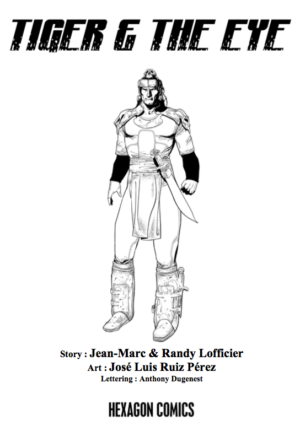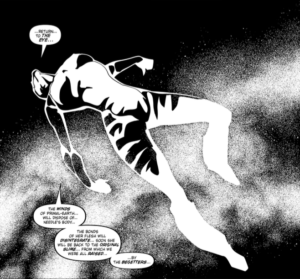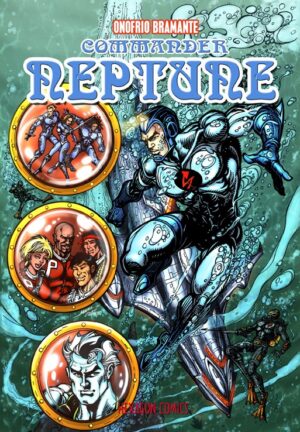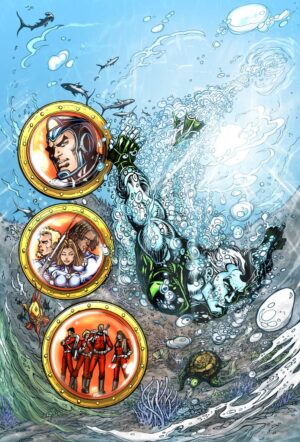 “What if….” are two power words forming a question. They’re also the title of a great Marvel comic series and the question serves as the basis to our interview with Jean-Marc Lofficier.
“What if….” are two power words forming a question. They’re also the title of a great Marvel comic series and the question serves as the basis to our interview with Jean-Marc Lofficier.
That question is: What if another comic company created a Mayan technofuture world before Marvel?
The question assumes you know Marvels movieverse just introduced Namor’s kingdom in Wakanda Forever as exactly that, a Mayan technofuture.
The answer would be presented in Tiger and the Eye from Hexagon Comics created by Jean-Marc Lofficier and Jose Luis Ruiz Pérez and published five years ago.
JOESEPH SIMON:
What if? It’s a fascinating theoretical mental exercise that fills up many pages of comics and books as well as hours and hours on TV and movies. The ideas of alternative timeliness, as well as living in a simulation and parallel Earths and multiverses are getting closer to actual science than ever before.
With that in mind, as these concepts go mainstream, it’s no wonder Marvel is doing it now…where Marvel is utilizing the Mayan technofuture idea for Namor’s underwater kingdom, you used it to represent an entire alternative reality 5 years prior.
What led to your creating Kab Earth and writing Tiger and the Eye?

JEAN-MARC LOFFICIER:
The idea goes way, way back. The notion of setting up a thriller in a Mesoamerican culture first took root after we discovered Tony Hillerman’s remarkable novel Skinwalkers (1984), but it was further fueled by reading the wonderful non-fiction books A Forest of Kings and Maya Cosmos by David Freidel & Linda Schele, as well as a collection of Mayan folk tales entitled The Bird Who Cleans The World by Victor Montejo. (All three are highly recommended!)
JOESEPH:
I plan to see Wakanda Forever and hope for the best. Namor is an important part of the comic book universe and is deserving of the same in the movies. What do you think of Marvel’s use of the idea for Namor’s underwater kingdom, years after Tiger and the Eye was written and published?
JML:
I haven’t seen Wakanda Forever yet. (I’m waiting for it to be available on Disney-+.) Personally, I was very fond of the original Atlantis depicted in the Marvel comic-book universe, and its long history going all the way back to Robert E. Howard’s Kull. I had even contributed a smidgen to it when I co-wrote (with Roy Thomas) the origins of Varnae, the very first vampire. But the notion of recasting it entirely as an underwater Mayan kingdom is interesting too. Certainly, from a visual standpoint, it offers more possibilities. I also wonder if Marvel didn’t do this to purposefully not copy the Atlantis of DC’s Aquaman, which chose to remain cast in a more traditional slightly Greco-Ronan look.

JOESEPH:
It’s fascinating, in America, with what’s has been happening of late in the nation politically, we discover how close, if not for singular actions of individuals, our recent past would have rolled out differently. Entire nations if not the world could have been different if this or that didn’t happen. Going farther back, what would have happen in native American’s in North America continued their rule? What if Spain or France had different plan for what land in America they had initially colonized?
JML:
As someone who co-wrote quite a few What If…? For Marvel, I confess to liking the theme of parallel universes, alternate realities, best embodied in science fiction by books liked Fredric Brown’s What a Mad Universe or H. Beam Piper’s Kalvan of Otherwhen. With Tiger and The Eye, José and I took a starkly different approach in the sense that the point where things change isn’t at all recent (like, What if Napoleon had won at Waterloo?) but goes back to probably something like 10.000 B.C.
 JOESEPH:
JOESEPH:
Why did the Indo-American civilizations falter and how did the MesoAmerican culture rise in Tiger and the Eye?
JML:
I didn’t work it out exactly, but one may infer that some kind of diseases wiped out, or at least severely impacted the Aryan cultures of Central Asia, Europe and Africa, leaving the Meso-American cultures free to develop without competition. The challenge was not only to invent what such a culture would look like (there, we can rely on archeologists and anthropologists), but to project it into its own future.
JOESEPH:
The idea behind the alternative world you created in Tiger and the Eye are not without merit. To imagine such stories takes a lot to write convincingly. Knowledge in culture and history is essential. With Tiger and the Eye, you took into account the Mayan culture. Being an alternative futurist must also comes in handy while your imagination and creativity is the glue that binds it all together. What various aspects of above did you weave into Tiger and the Eye? What helped you create this world?
JML:
Randy and I relied strongly on the books I mentioned above. José provided a degree of pure cultural authenticity which few other artists could have achieved, and we are indeed very grateful that he chose to embark on this journey with us.
 JOESEPH:
JOESEPH:
What difficulties did you have bringing all these things together? Who are Tiger and the Eye? What makes them who they are? What abilities do they have?
JML:
Having a universe figured out is a good starting point, but you still need a story, characters, heroes, villains, motivations, etc, etc. Drawing inspiration from Tony Hillerman, we had decided at the onset that our two protagonists, Tiger and The Eye, would be private eyes in the well-trodden tradition of Raymond Chandler, Dashiell Hammett, etc. As we played around with the characters, the idea evolved that The Eye would be the one with clairvoyant powers, the ability to speak to the dead, and he would be a jaded ex-cop. His partner, Tiger, comes from the underclass of people created from animal DNA. The idea was inspired by Cordwainer Smith’s Instrumentality novels– the character of C’Mell. Their relationship was also influenced by that of Modesty Blaise and Willie Garvin in Peter O’Donnell and Jim Holdaway’s eponymous British comic-strip from the 1960s.
 JOESEPH:
JOESEPH:
They are not a couple, what do you consider them?
JML:
They may have had sex a few times, just to get it out of their system, but they’re not lovers. They’re partners, and good friends. It is kind of implied The Eye may have rescued Tiger a long time ago; he may even have lost his job because of it. So she is fiercely loyal to him.
JOESEPH:
All these ideas of different kinds of Earths, histories and the like you are no stranger to. The Hexagon universe is a vast and multi dimension one. How do all these ideas play in the greater scheme of things for Hexagon?
JML:
One of the peculiar discoveries made in the world of Tiger and The Eye was the ability to cross into other worlds by using what they call “wayak” technology, which became the core of the plot in the overall arc of Strangers Season 5, in which a group of five villains gang up together to conquer the Multiverse (as it were). But none of this matters much at this stage, because the Tiger and The Eye story we published is entirely self-contained and refers only to what is happening on Kab-Earth. However, they will return in Strangers Season 5 and in due course, play a very important role.
JOESEPH:
There is a tad bit more sexuality in this reality than your average Marvel, DC or even Hexagon title. Is that due to the characters or the reality you created?
JML:
I hate the word “adult,” but I know what you mean. Tiger and The Eye is definitely a more “adult” story. I think the reason why, first and foremost, is the world in which the characters operate. It is a savage, opulent, barbaric society. Think HBO’s Rome or Robert Graves’ I, Claudius. It is not a nice place, and if Conan, for example, was done “accurately”, it would also be very “adult”. The fact that the characters are private eyes investigating murders in the High Society doesn’t help either!
JOESEPH:
You are joined by artist Jose Luis Ruiz Pérez. His unique art sets an interesting visual interpretation to Tiger and The Eye. How much creative freedom did he have in setting up the visual nature of Tiger and the Eye?
JML:
Total, unrestricted freedom. José has worked in Mexican comics for forty years, including on the Mexican versions of Tarzan, Korak, etc., so he was absolutely perfect for the job. Plus, he lives in Yucatan or thereabout, so he was physically, culturally and emotionally close to the subject. He also made some very valuable contribution to the story in terms of adding things that weren’t in the original plot (we work using the Marvel method) which I then incorporated and expanded upon in the finished story.

JOESEPH:
Speaking of Wakanda Forever, the new found attention to Namor is interesting. Where Namor has been an important character at Marvel, much like Aquaman has been to DC, Hexagon is not without its own undersea heroes. In fact, from January to March, you will be releasing 3 books featuring Hexagons undersea heroes. Can you tell us more?
JML:
It is, in fact, a coincidence. I wasn’t thinking at all about Namor or Aquaman. Initially, I just wanted to do The Sea King, because he had guest-starred in an earlier issue of Strangers and I thought the readers would enjoy seeing the original version; then, one thing led to another, and I decided to do three books, each with two sample reprints of classic series from the 60s and 70s, under the collective portmanteau title of “The Lord of the Depths.” So in January, we’ll release Sea King + Bathy-09; in February, Commander Neptune + Patrol of the Depths; and in March, Oceania + Marino. The only one of these characters who hasn’t appeared in Strangers is Oceania; all the others have returned. The analogy would be DC releasing a sample series consisting of reprints of Aquaman, Aqualad, Sea Devils, Dolphin, Cave Carson, etc.
JOESEPH:
People were pretty quick to think make comparisons between Namor and Aquaman. While both are their respective companies’ main underwater hero, with each ruling over their underwater kingdoms, there are a lot of differences between the two. I mention this because you and I will, in fact, be having further discussions about your underwater heroes in future interviews. To wet the readers curiosity, give a little summery of each undersea heroes you are spotlighting and how they are different from what people expect from underwater heroes. How are they different than Marvel’s Namor and DC’s Aquaman?

JML:
Sea King is more like the old TV series The Man from Atlantis, except that he is a human genetically modified. Bathy-09 and Commander Neptune are more like DC’s Sea Devils, or the TV series Voyage to the Bottom of the Sea. Patrol of the Depths is like DC’s Cave Carson. Marno is a member of the group Kidz, and I guess you could think of him as an Aqualad of some sort. As for Oceania, it is a little like a Flash Gordon-type story, except that it takes place underwater, and likely in a parallel universe. Some of the characters, but older, will return in Strangers Season 6. Together, these are a good sampled of the diversity of comics and characters published by our predecessor, Editions lug, in the 60s and 70s.
Thank you Jean-Marc. There’s lots of exciting comics like Tiger and the Eye in the Hexagon catalog and forthcoming comics Hexagons “Lords of the Depths” 3 month event.
You can purchase Tiger and the Eye on Amazon or directly from Hexagon.
Hexagons 3 issues of undersea heroes starts in January. Keep up on Hexagon on their website and/or Facebook.
